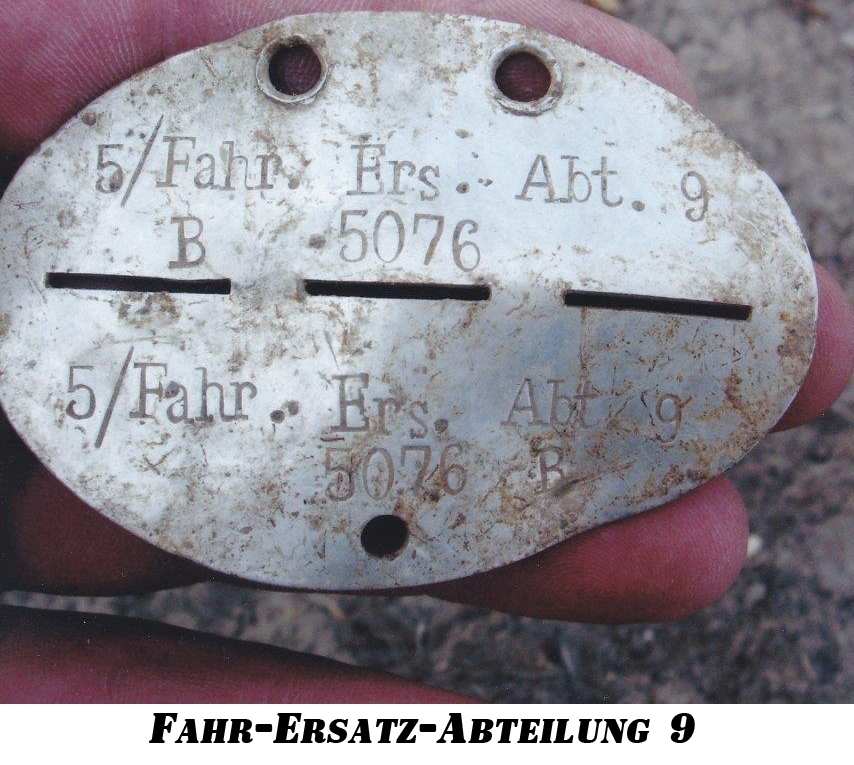I've already mentioned in this article that the most popular finding at the Stalingrad battlefield among those, that carry a price besides coins, buttons and others, are dogtags.
According to Wikipedia, the German army losses (not to mention allies) in Stalingrad were 400 thousand people. According to another information, the losses of Wehrmacht and Luftwaffe were 660-710- thousand people. Each soldier and officer had an ID tag. It’s not surprising what a huge number of tags have already been found and how many more are still in the soil.
Now I would like to say a bit more about what tags can be seen at the Stalingrad battlefield.
5 ID tags of the 576th Infantry regiment included in the 305th Infantry Division of Wehrmacht were found on the Northern skirt of Volgograd in 2007. The division was destroyed in January of 1943 In the Northern part of the Pocket. It’s unusual that the data was written in the semicircle.
The next dogtag I’m going to talk about is 5.Fahr.Ers.Abt.9 (Fahr-Ersatz-Abteilung 9), which was found in the airfield Pitomnik area. The owner was a horse-drawn driver. According to two worn-out holes a soldier wore it laced right down the line, which was rather unusual. The ID-tag was found in the field, and the remainings were not found in the area.
6 ID tags (ex., 3.Komp.Jnf.Ers.Btl.92 и 01.Ers.Battr.15), War Merit Cross and Panzer Badge were found in one and the same Gumrak airfield area. As you can see, different Wehrmacht division were located in the same place. I can suppose that those were the wounded, who came to the airfield aiming to leave that hell.
Now we’ve come to the most interesting. In what places, do you think, are most of the founding done during archeological diggings of German positions? I made a small TOP-5 list from the prospective of the most interesting digging places.
- Combat positions, large battlefields. It’s clear that the larger the battle is, the more soldiers and officer died there, who probably are still resting right where the bullet or the fragment caught them… As for us, we don’t dig on battle positions often, there\s so much metal waste like bullets and fragments that we can barely find anything worthy from 1000 signals…
This tag was found in the district of pontoon crossing near Vertyachy village, where hard fights happened. ERS.Kp.F.GEM.M.G.E.10 - Ersatz-Kompanie für gemischte Maschinengewehr-Einheiten 10, which can be interpreted as “the 10th reserve troop for recruiting mixed machine-gun teams”.
- Lived-in positions with dug-outs, trench-lines and pillboxes. When the front line is more or less stable for a long time, troops make dug-outs, build trenches, and the longer soldiers live there the more mess they make. In other regions, such places are northern and western town ends. This is where we search out.
For example, such dogtag was found in a tent camp in the western town end of Stalingrad in 2008. Wehrkreis Ersatz Depot XII
- Second lines. There are also lots of interesting findings in the places where warehouses, big railway junctions, airfields, repair workshops were located. Such findings in Stalingrad are a big field camp to the north of the Trehostrovskaya township, which is on the right riverside of the Don river. Is was a huge German second line camp with its streets, signs, stone paved highways, ammunition and weapons warehouses, repair workshops. It’s obvious why the first thing Soviet troops did after an assault was tightened around the 6th Army, was hurl into capturing that important strategic point of the Paulus army. When the Red army approached the Trehostrovskaya township, the Germans burned down warehouses and backed off through the Don to Stalingrad without hesitation.
Kol./ Bau Btl. 110 – Kolonne Bauten Bataillon 110 and M35 helmet were found in the Trehostrovskaya township area
- Prison camps. As Wehrmacht soldiers spent a very long time in such places, the amount of dogtags found there is also big. I personally know 5 big camps for German and Romanian prisoners in Stalingrad region - in Dubovka and Solyanoy villages, Rassvet and Krasnoyarsky farms and also to the south of Rudnya city. Found awards weren’t as usual as dogtags. It’s due to the fact that when Germans yielded themselves prisoners, they tore and threw off their orders and medals as they were in fear of the Red army soldiers revenge, but along with this they kept tags, because they believed they barely had chances to return from the prisoners… Despite of heavy mortality at camps territory, it’s impossible to find soldiers remainings, because all bodies were obligingly buried in big common graves in order to avoid infectious deceases. As a rule, cemeteries were located near prison camps, but not always…
Things found near a prison camp in the Rudnya city area - 7./A.R.216 - 7.Batterie/Artillerie-Regiment 216 (7th battery of the 216th artillery regiment) and 5.Kol.NACHSCH.ABT.602- Nachschub-Kolonnen-Abteilung 602
- Cemeteries of Germans soldiers and officers. Diggings in these places are performed by a German organization of the died in the Eastern Europe search and reinterment (VBGO). And every year this organization finds and finds remainings of the died 74 years ago in this frightful and blood Stalingrad battle. Once I had a conversation with a local resident of Rassvet village, and he told me that VBGO diggers found more than 300 soldiers of the 6th Hitler army in the 3*5 meters pit that he showed me…







